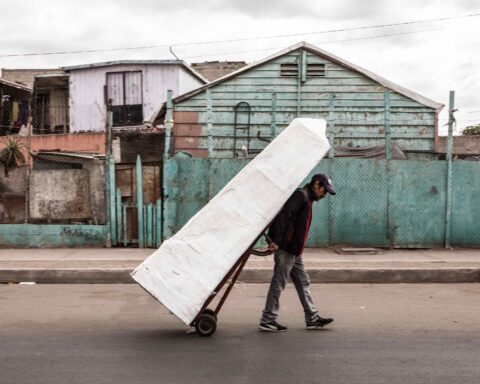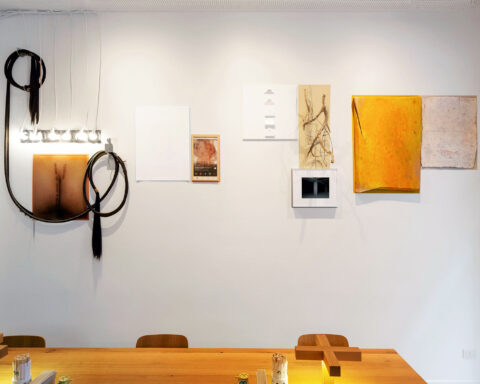In the panorama of digital art and multimedia innovation, few names shine with the same intensity as Studio Azzurro. Today we celebrate the extraordinary journey undertaken by this collective of visionary artists. With a career spanning more than four decades, Studio Azzurro has consistently redefined the boundaries of artistic expression, pursuing a bold mission: to unite traditional art and advanced technology into immersive and extraordinary experiences.
Founded in 1982 by Leonardo Sangiorgi, Paolo Rosa (1949-2013) and Fabio Cirifino, Studio Azzurro has become a point of reference in interactive art, pioneering new media to explore the relationship between spectator and work. The studio has challenged artistic conventions through immersive installations, multimedia performances and innovative projects, embracing digital evolution with limitless creativity. They were joined from 1995 to 2011 by Stefano Roveda, an expert in interactive systems. Through the creation of “video environments”, “sensitive environments”, museum tours, performances, films and theatre shows, we create a transversal path between many disciplines and form a working group open to different contributions and important collaborations.
In recent years, Studio Azzurro has continued to leave an indelible mark on the world of contemporary art. Their works, enchanting and provocative, have touched deep emotional chords, taking the public on extraordinary journeys that go beyond simple artistic contemplation. Studio Azzurro has left an indelible mark on the contemporary artistic panorama through the creation of sensitive environments, video environments and video installations that challenge conventions and offer unique experiences.
The sensitive environments of Studio Azzurro are interactive spaces in which the public becomes an integral part of the work, transforming the viewer from a passive observer to a protagonist of the artistic experience. This form of active engagement represents a milestone in the evolution of interactive art.
The video environments produced by the studio are immersive journeys through extraordinary visual and sound worlds. Using advanced technologies, Studio Azzurro has been able to capture the imagination of the public, taking them to otherwise inaccessible places and offering a unique perspective on the relationship between space, time and perception.
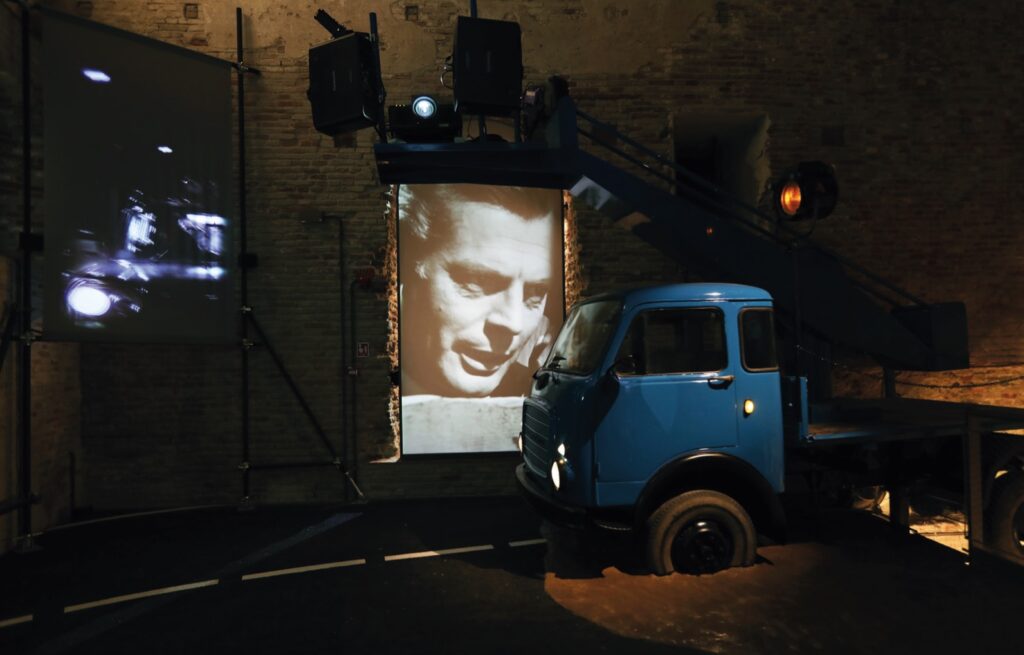
Studio Azzurro’s video installations are works of art that go beyond the simple screen, transforming physical environments into virtual canvases. This fusion of technology and creativity has redefined the concept of art installation, inviting the public to immerse themselves in complex and engaging visual narratives.
In summary, Studio Azzurro has revolutionized the contemporary artistic landscape through the creation of works that go beyond the traditional boundaries of art, pushing viewers to explore new sensory horizons and reconsider their role in the artistic experience. Furthermore, they have attracted the attention and praise of numerous curators and critics in the contemporary art world. Prominent figures have helped shape the critical debate around the studio’s innovative work. The following interview will allow us to delve into the beating heart of Studio Azzurro, exploring the roots of their inspiration, the key moments of their career and the future vision that continues to guide their creative path.
Marika Marchese: How was Coro born?
Leonardo Sangiorgi (Studio Azzurro): Coro was born out of a great desire to investigate interactive possibilities. Let me explain, at the end of the 80s and the beginning of the 90s there was the great technological leap in which analogue technologies became digital and this happened, in a sort of prologue, even if apparently it had nothing to do with the “swimmer ”. We tried to interpret the collective imagination of people, in those places and at that time, with The Swimmer (Going to Heidelberg too often) we proposed a life-size electronic figure, which was difficult to see at that time because we only had televisions. In short, it was possible to see people whole or 40 cm tall, that is, life-size in the half-length portraits of the news. The intuition did not come immediately, but we had three principles, three nodes that we wanted to investigate through digital and interactive multimedia systems. One was certainly the theme of chorality and it is no coincidence that Coro, which is the name of the installation, was not interested in investigating the 1:1 relationship between device and user, but the interaction between people who participate in the dialogue between devices. Here perhaps it responds indirectly to the issue of immigration, but we wanted to focus on inclusiveness, that is, opening up to participation. We wanted to create a mutual relationship with natural interfaces. We wanted the dialogue between user and device not to take place through keyboard, joystick, or mouse but with something closer to each of us, and therefore touch, the weight of people, their movement, voices, and sound. Thus it was that, intrigued, with more knowledge, we began to cross paths in our research with those of other professionals, not least Giulio Calegari, a paleoarchaeologist specialized in African cultures. Known by Paolo, he told us about his works and how archaeologists proceed by laying grids on the ground, also telling us about the cultures in which the textile dimension, and almost distorting what has always been known, that is, this an activity reserved for the female world supported the culture, the clan, and the tribe, and completely overturned everything. Weaving implies knowing how to count, both the number of children and the number of passages of the warp and weft to arrive at the design therefore counting was a truly great power that in these cultures women had, even in certain cases becoming a dominant knowledge. Well, all these ideas, suggestions and knowledge have been intertwined and condensed in Coro’s project which proposes a large carpet which, as a natural interface, must be crushed and, unlike traditional ones, has its own life, activated by the visitor. The grids of the carpets are active by the archaeologists who, box by box, work on the various layers to learn about the history, telling about the past therefore there is this sort of analogy because the carpet in its apparent mobility can tell stories that are always in motion.
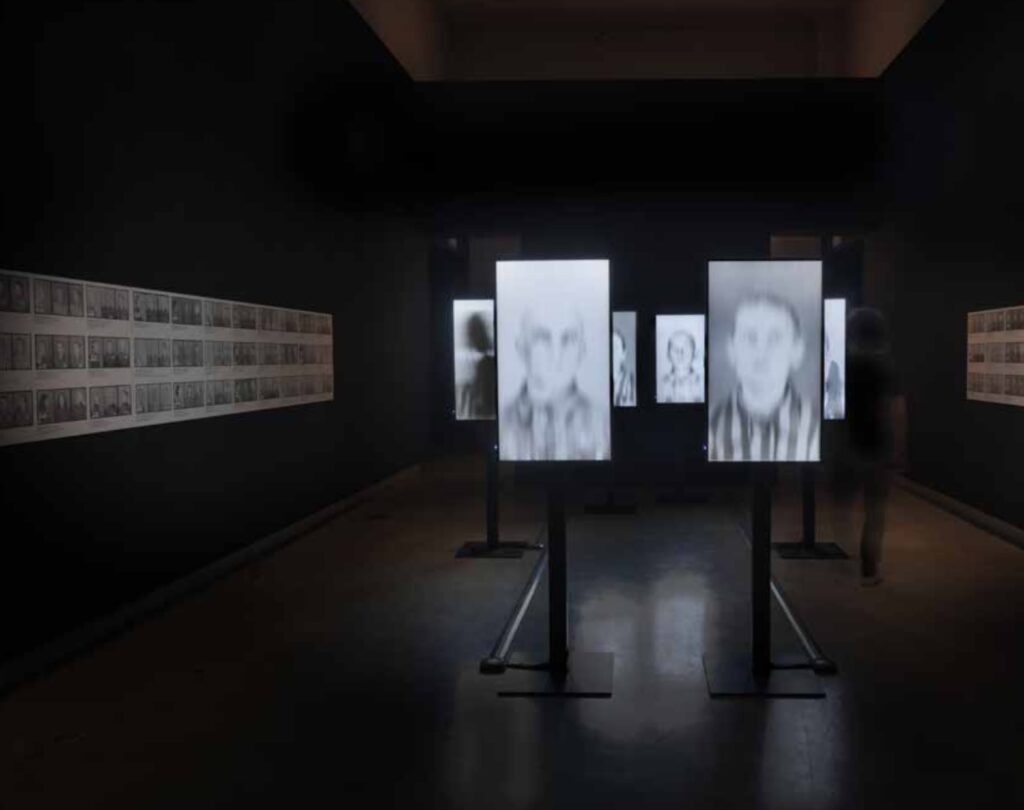
M.M.: How did you approach interactive video installations? Did you rely on external researchers, in addition to Stefano Roveda?
L.S.: Once again it all came from natural interest. At the end of the 80s, RAI (Radio Audizioni Italiane) used projectors, which at the time were called Eidophor, which, through an RGB disc, allowed the projection of electronic images. After this, the technological leap introduced liquid crystal video projectors with a series of advantages, in addition to being smaller, they were functional on any surface and inclination. This allowed us to project electronic images not only based on any type of surface and to experiment with sensors and interaction, pushing our imagination even further.
After the chorality, the natural interfaces, the third theme concentrated on the storytelling methods, the narrative segments.
Narration has always been a theme that since our first works is linked in all parts to the great, main and fundamental theme: space.
There is no installation project by Studio Azzurro that is not regulated, sometimes dominated, by the presence of space, unlike some video artworks which only appear two-dimensionally on the wall.
M.M.: How do you design your works? Do you study the location first or adapt the work?
L.S.: Space has always been an element present in our projects, even Luci di Inganni (1982), the very first project envisaged a relationship between multimedia content as they say now but at that time we called them “video programs”, the technologies therefore the television and the space in which these technologies as in the programs were placed, and the importance was evident. In a period in which design, architecture, dance and theatre were the disciplines that proposed original language solutions that could be crossed and very probably Luci di Inganni, the first work was as if to say it is evoked by the work of Memphis, (a famous group that brought the design to the world through Ettore Sottsass and Associates) who wanted to present their design objects and we responded with objects that existed only through television programs (the project was been reinterpreted in a totally new way for Design Week 2023)
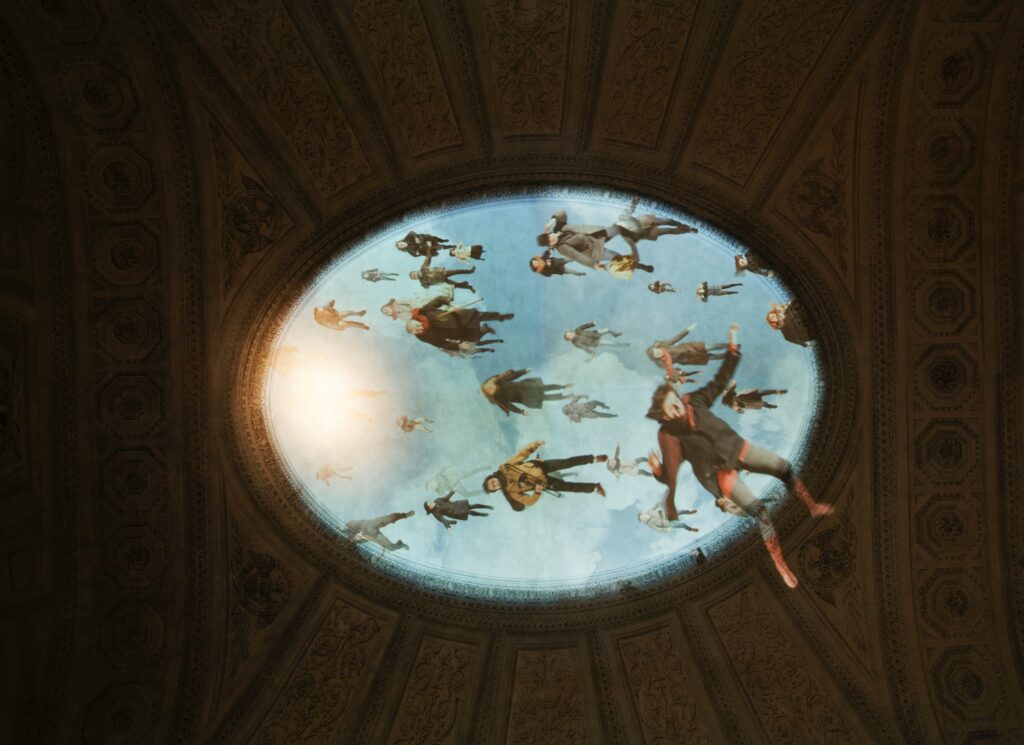
M.M.: The themes of memory, of the Other, of the body, as subject and object, used and abused, were a commitment for you. Are they still? What other social and artistic commitments have you carried out?
L.S.: For the Salone del Mobile in ’82, we had done Luci di Inganni and this project, this first video environment, as it was called, was like, it made an impression. So much so that at the time Carlo Massarini who hosted Mister Fantasy, tried to re-stage it in the program and for the occasion he created a neologism to explain our work, he defined us as “video explorers”. In fact, at that time, research on videos was carried out by very few people and we, driven by this flow of investigating this medium that was now beginning to pervade our lives: video clips and free TV, was quite natural.
M.M.: The swimmer, strongly desired by the curators in 1984 of Palazzo Fortuny in Venice, which we saw again at Artissima 2023, what idea does it have behind it?
L.S.: The following year we proposed Luci di Inganni again for Memphis, Sottsass asked us to think of something new and “The Swimmer”, began to be born, due to the fascination of the water in the video, which was truly very strong. Perhaps due to the complete extraneousness of the two media, the electrical and electronic dimension and the liquid one but also the same synergy of electrons that move just as the particles of water and then the blue of water move. It returned with a certain effectiveness that was truly very compelling.
So little by little we begin to put together the theme of water and we begin to think about the possibility of creating a life-size electronic figure. Due to the initial difficulty of putting together all the technological, theoretical and productive elements, the project failed. At a certain point, we came into contact with JVC, this Japanese company that was the creator of the VHS format and at that time, still at the beginning of the 80s, the willingness of large companies to experiment was really high and therefore we began to enter in contact with this company which in turn put us in contact through rounds of people and situations, with Silvio Fuso and Sandro Mix, the two curators of the Documentation Center of Palazzo Fortuny. The photographic archive became an important video archive, therefore with the two curators and with the desire to increase the attention and importance of the research activity that we developed with JVC the theme of the swimmer, who moved through the monitors used as a mosaic and the project was born.
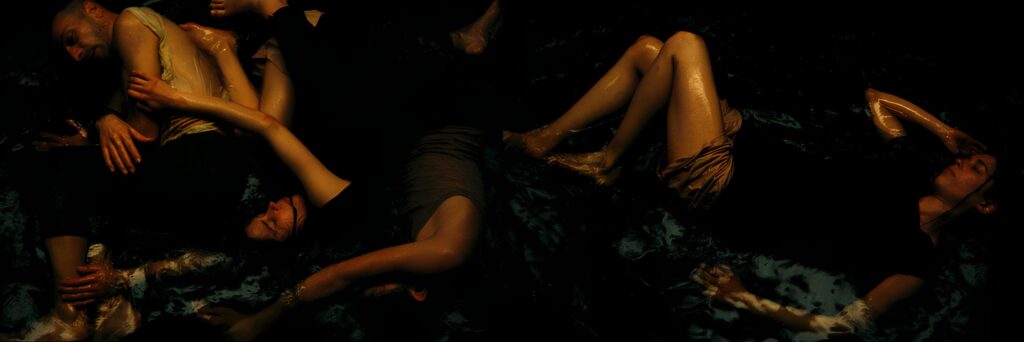
M.M.: Why did you choose to propose again The Swimmer (Going to Heidelberg too often) at Artissima, in the form of a 1:1 scale maquette, and why did you choose the Benappi gallery?
L.S.: Then the Benappi gallery contacted us. In our history, work has always taken place and developed somewhat outside the traditional art market chain.
This was one of the topics on which Paolo, Fabio and I often discussed and we concluded that galleries with the system of critics, collectors and gallery owners were not the most suitable place to carry out the experiments we wanted. They didn’t leave us the possibility that other places of experimentation would have allowed and therefore all of Studio Azzurro’s work took place in other ways.
Another work of ours that was presented in Japan Landing Talk questioned in a somewhat peripheral way the parallelism, for example, between an opera by Mozart or a comedy by Shakespeare, staged even now through a score or a screenplay and we asked ourselves if our works could also live through the description and how they were created. On the other side, however, there is the other path, of having the possibility of keeping the work able to present itself, being a work that turns on and off.
Speaking of this, Paolo had his idea and it was a fun idea, what our work is ecological, compared to other artists, because if a work is ugly you turn it off, whereas an ugly sculpture cannot be turned off and an ecology of multimedia works in a certain sense.
We had spoken to some journalists from Il Sole 24 Ore who had done research on the video art sector in the art market and were beginning to collect a whole series of information. The main information we had was that the work of art and not just video art has the problem that all today’s technologies have, it must be viewed. Especially works of video art, video environments, or multimedia installations in which there is a whole scenographic and spatial aspect in which the reference figures are more similar to museum curators rather than collectors. To think that in 1982 when we created Luci di Inganni, again with Memphis objects, we found a customer who, in addition to buying a teapot by Matteo Thun, bought the video teapot with the video smoke from whose spout near the monitor he threw smoke out coloured. Here he bought us the VHS of video smoking which in those days with portable video recorders he kept on when he wasn’t watching television programmes.
So we were interested in the galleries to understand what strength and willingness there was on the part of gallery owners to purchase, promote and safeguard multimedia works. We had contact with the Verrengia gallery in Salerno which presented a series of works and photographs thanks
to Fabio Cirifino, who is a photographer as well as director of photography of Studio Azzurro. Therefore there was and is the desire to make the video documentation that accompanies all of our work more visible to make the video environments and sensitive environments that we have created more perceivable and understandable.
A little enlightened, in our choice, by our tutelary deity Marcel Duchamp, who was one of the first to create boxes and suitcases that contained his works in miniature, we too have practised this idea of creating large container suitcases in the what were the most important sensitive environments, video environments that we created. From this point of view, we were helped and we did a sort of co-work with the Installations Laboratory of the School of Design of the Polytechnic of Milan which threw itself into the project headlong with us. We have created around 18 or 20 working models of video environments and sensitive environments.
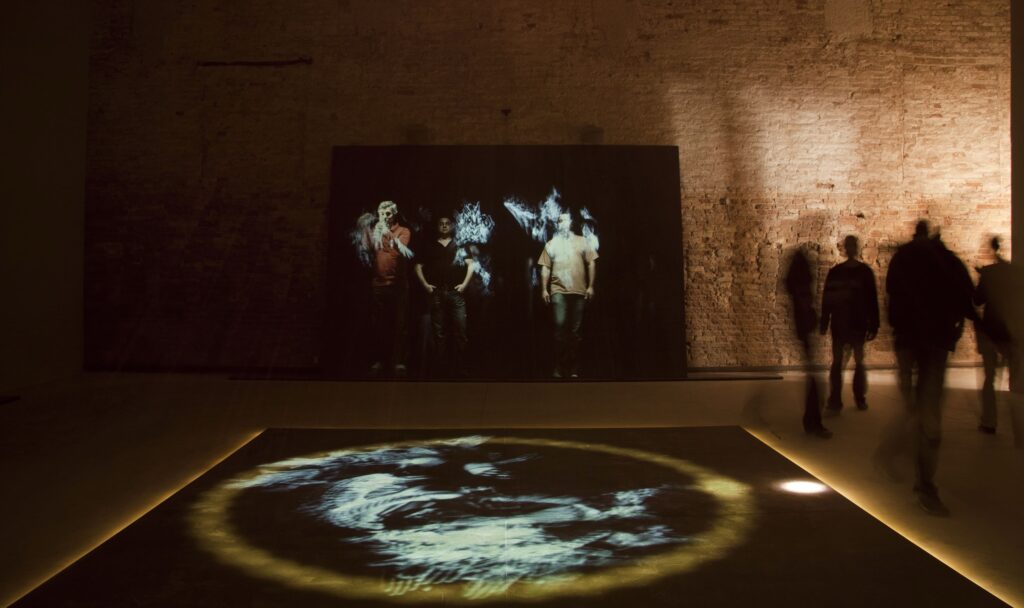
M.M.: Theatre, cinema, stories of men and feelings. Who and what did you bond with during the study and implementation of the projects? Were there external figures with whom partnerships were born?
L.S.: It’s not a simple question. When we created the exhibition at Palazzo Reale, in Milan, Fabio Cirifino had the recklessness to start making a list of all the people with whom we have developed, worked and created projects and there are more than 200, so in this journey we have never limited ourselves to a specific dimension of art or video art but our work has been a continuous crossing of disciplines, figures, people and encounters.
The first works with the composers, who all became our friends, they called us “those with the cropped ears” because it happened very often to Paolo, Fabio and me (we have visual training, we are not technicians, as I said before Fabio he is a photographer, Paolo and I attended art school together and the academy) as much as we loved cinema, which was our first love, moving images, sound and music came slightly into the background. Now, after the reproaches of our friends, we have the sensitivity to perceive the integrity of two worlds, both the much more metaphysical one of sound and that of images, but here the first emblematic encounters were precisely those with the musicians who composed first works.
We used a soundtrack by Brian Eno, with whom we made a video for an installation work that had been exhibited in San Carpoforo in Milan, in the Brera district, with Tommaso Leddi, and Alberto Morelli. Another artist with whom we collaborated is Peter Gordon who created the Swimmer’s music and therefore we had many reference figures. All very important for us, also remembering those critics who had immediately perceived and recognized the importance of the expressiveness of that medium which was normally a household appliance, the television, and which instead began to become an instrument of experimental, evocative and original language.
M.M.: Films, books, interventions by and with philosophers or other personalities who have contributed to/enriched the production of Studio Azzurro.
L.S.: Starting from Vittorio Fagone, Valentina Valentina and many others and as usual, they slowly helped us a lot in this navigation. Because, as I repeat, we worked much more with our guts than with our heads and the work of the critics, of those like Bruno Di Marino and many others, were navigation tools, astrolabes that showed us whether we were staying on course or whether we had gone somewhere ‘other side.
Later, the experience with Giorgio Barberio Corsetti and the theatre was very important for us. Once again, verifying this video’s ability to metamorphose, an almost spongy ability to absorb from all disciplines, led us to a still very strong dimension, namely the encounter with philosophers. The sense that no later than two days, three days ago, we were in Cesano Maderno at the Palazzo Arese Borromeo which is the headquarters of the San Raffaele’s Department of Philosophy of the Image, where Francesca Pola strongly wanted us and curated and commissioned a workshop called “Laboratory rooms”. Francesca Pola curated the conference (created as a commentary on the book Portatori di storie, published by Mimesis Edizioni and published during 2023) in collaboration with Studio Azzurro and on behalf of the “European Research Center for the History and Theory of the Image ICONE”. The conference is part of the process of meeting between disciplines undertaken by the ICONE Center, founded and directed by Andrea Tagliapietra.
Taking inspiration from our Story Bearers Format, but speaking and listening to them very important reflections by Pietro Montani, Andrea Pinotti and Roberto Diodato spoke precisely about how the theme of image testimonies was defined as the moving matrix for multimedia works, and to what extent an interactive work through its ability to interact with people manages to maintain its original format whether or not there is the possibility that the spectator becomes a spectator- author and of pushing himself to change the meaning or intention of the interactive multimedia work.
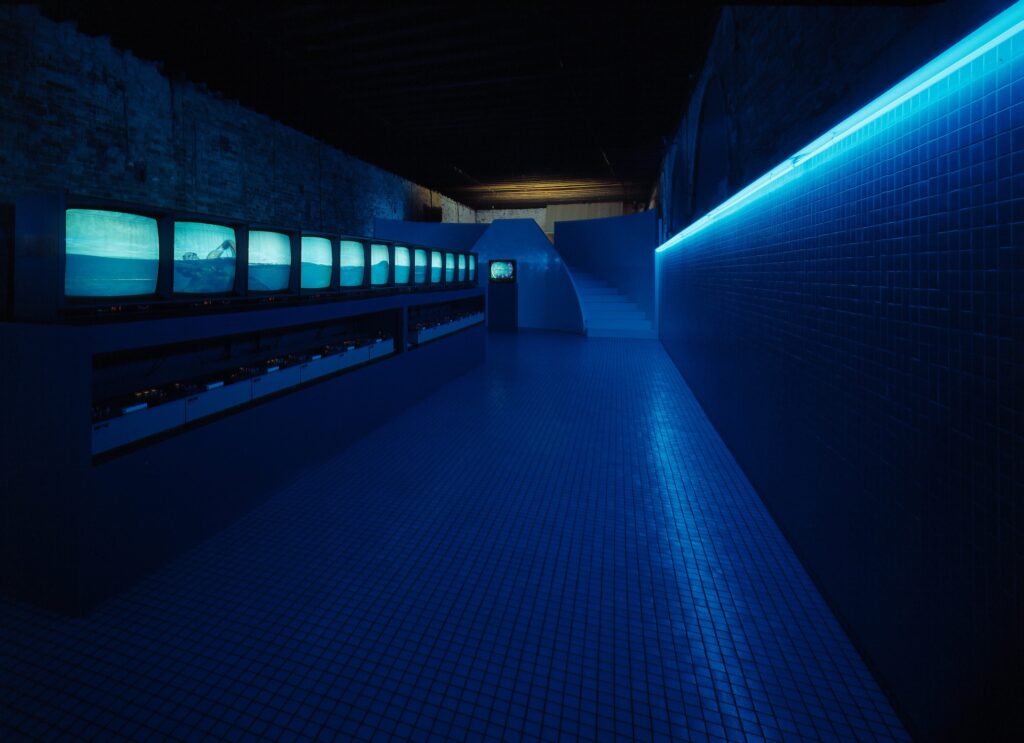
M.M.: What were the most interactive moments of your career?
L.S.: No, I hesitate, because I should answer with the last question on the list, the three words, then the advance. I had thought of four words, but two can be read together, “it can’t be done!” When we hear this type of statement from technicians, that is the door to start researching and developing. And our relationship with technology has always been like this. It happened to us in Italy but also abroad, and it was the task of those who put the technicians, the researchers, to the test. Always arriving at point A and the world that hasn’t quite arrived there yet… At the beginning it was certainly like that, perhaps still now in some ways.
I remember that in Japan, one thing that struck me was that they sometimes proposed the possibility of finding some dreams that could be realized. I remember back in the days before DVDs, CDs contained a very small amount of images.
MM, have you had the opportunity to experiment with artificial vision systems?
LS: More than twenty years ago when the theme of the network, of what the Internet represents, began to be important for our lives, the Tamburi installation was an incursion of our work into computer networks, through messages that were produced and written by percussion. The development of technologies has helped us understand and grasp different meanings, such as whether they could also have a poetic dimension, or be used for purposes other than military or designed, created and developed only for the people who use them. Like a sort of antibodies, being immune to them, and making us more aware of the functioning of these means and the methods of research. We have known and used these augmented reality and virtual reality devices, in some cases in museum-type creations where they lend themselves to mediation between the public and the project. However, one thing that has always limited us in our exploration is the fact that on these means the body has a limit, it is put in the background, and instead for us the bodily dimension remains highly fundamental because it is perceptive. It is no coincidence that we were talking about space right from the beginning and when you, the observer, have a space at your disposal, you can move, and observe at any point and you can look at the work from another point of view. You are a fourth author, the last director of that work because you compose in space, your last version of the work of art and this is fundamental for us just as the relational space is fundamental, which cannot be replicated through social media.
M.M.: Darkness is present in many of your works, metaphorically we are witnessing a rebirth, both of storytelling and the video tool, to analyze all the ways of “feeling”. The “space around us”, whether it is a space of respect or a world of things, to quote Heidegger, is no longer just physical space. You have, in some way, also contributed to studies on perception.
L.S.: At the beginning of November, there was this conference in which we participated, including the speech by Vittorio Gallese who presented the theme of mirror neurons, then Pietro Montani focused on another very strong theme regarding imagination or rather, the distant relationship between artificial intelligence and human intelligence. The artificial one could be “versatile” while the human one is “plastic”. Its strength lies in the sense of being predisposed to making mistakes, to learning, to connecting. While the artificial one is also infallible when it comes to “reproducing behaviours” which in all appear to be neural systems that simulate human choices. The ease with which the human mind makes mistakes emerges.
They were two very intense days in which many elements were accepted and we are still trying to process all this data.
M.M.: If today you were to participate in the Venice Biennale again, what would you like to accomplish? Speaking of secret dreams, what would you like to see come true?
L.S.: There are different themes but now I don’t know if I’m anticipating, I think we’ve been wondering for a while what Studio Azzurro will be like in another 40 years. Well, Studio Azzurro is a single soul in many heads and here the heads do not always correspond exactly to the soul. It’s no coincidence, sorry, I’m making a small detour, after the exhibition at Palazzo Reale in Milan, we didn’t want everything to get stuck in a city recognition, but we immediately thought about what to do next, how to continue. We tried to understand what directions of work to take and two directions arose. One of Fabio’s interests is dedicated precisely to the “bearers of stories” and to the workshop from which what we have already talked about was born, namely in collaboration with Laboratory of the School of Design of the Polytechnic of Milan. With the “bearers of stories” both as a format and as a very strong political gesture, we wanted and want to give a voice to those who don’t have one. Among other things, “bearers of stories” have become, in addition to an installation, also a theatrical show and this format has been transmitted to other people, to schools, in other places, to ensure that the intangible assets, those cultural assets can be collected, saved, and displayed appropriately. Fabio is taking care of everything and for my part I’m taking an interest because I don’t know if it’s spontaneous or if someone has evoked this question but looking at how life is and the great technological development, I have to say very little spiritual development, particularly at this moment in which people still kill their peers, or starve them to death, when instead there would be many other possibilities… We ask ourselves whether the time has come also for the technological tools we have now, which are very strong, and very powerful for our relationship with the outside world, to start exploring an aspect of man, the internal one in relation to our planet and the many people with whom we can afford to come into contact.




